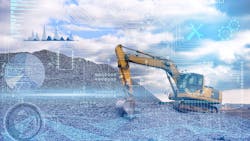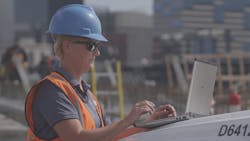Bechtel is working on using machine data harmonized by the ISO telematics standard to determine a metric for carbon output on its job sites. According to Cody Meeker, global fleet manager, the multinational contractor wants to use the data to create a carbon intensity metric.
Meeker, speaking on the panel discussing the “Future of Safety and The Connected Jobsite” during Trackunit’s Next 2024 webinar, said that there are many ways to do a carbon metric, taking a data point and dividing it into carbon output. He said Bechtel’s goal is to have its entire fleet connected via telematics so it can monitor the data to lower carbon output.
“We want to take our data and say, ‘Our fuel burn equals X amount of carbon divided by something,’” he said. “We’re trying to take that data and come up with that industry standard that everybody can say, ‘This is your carbon intensity metric.’”
Read also: Renewable Diesel Holds Promise for Fleet Sustainability
Meeker emphasized that the data Bechtel is considering is available to everyone using the telematics standard, which would give fleets a standard metric. On Bechtel job sites, he said, they want to be able to use data to let managers know how wasting fuel and emitting carbon dioxide affects production on the job.
“A lot of the data that we’re monitoring—it’s obviously utilization, idle times, operating times—because what we really want to monitor right now is our decarbonization efforts,” he said. “We’re trying to take a lot of data, analyze it, and provide predictable outcomes to our projects.”
Challenges remain for data harmonization
John Mongan, also on the panel, said the ISO standard is a “good start,” but it is still not widely adopted and hinders effective equipment diagnostics. The industry still has a way to go in discerning the difference between “nuisance” codes and actionable insights, he said.
“I think there’s a lot more to do there, helping make sense of what we’re seeing coming off of the equipment,” said Mongan, director, advanced concepts, for United Rentals. “We’re certainly investing in being able to differentiate between the two.
“For contractors the size of Bechtel, for rental [firms] the size of United Rentals, I think the challenge is a little bit different because we have the scale to invest in teams that can harmonize some of this data,” he said. “But when I think about the industry as a whole, that’s where the benefit would really come in from this standardization.”
United Rentals has used machine data for years, Mongan said, primarily location data to reduce the number of lost machines. But the rental giant is working to provide more customer insights with data, specifically to guide productivity metrics using utilization data.
“It sometimes seems counterintuitive,” he said, “but we want to provide our customers insights into what rental equipment are they not using…and we can pull off rent. That’s a productivity benefit.
“Where I see it going is toward more sophisticated information,” Mongan said. “Our customers want that information about how the equipment’s being used, where there are maintenance problems. Ultimately, that’s the best kind [of] eliminating downtime we can get to: If we provide equipment to a site, we want to be able to guarantee that it’s up and running at all times. Those unplanned breakdowns—avoiding those is critical for us.”
Data drives safety
Mongan said there are opportunities for safety gains from data that manufacturers have begun supplying, specifically in terms of access equipment.
“How can I know if an operator out in the field is using equipment in an unsafe fashion? Overload weight on an aerial work platform, okay, we have that data point,” he said. “But what else can we do that might suggest a need for more training or a need to change processes to work a little bit more safely out in the field? That’s untapped potential, in my mind.”
United Rentals is also looking at video telematics to increase job site safety.
Read also: URI Equipment Access Uses RFID Tags
“AI on video is an interesting opportunity,” Mongan said. “The ability to take a video feed—either on equipment or stationary video—and understand where were the near misses, where are the pinch points, where there’s too many people and machines working together. I’ve been impressed by those types of insights.
“We need to figure out how we integrate that into operations on the job site,” he said. “That’s a little bit of a challenge, but the technology’s really come a long way in what it can provide.” He said technology can also provide good coaching opportunities for those working on the project.
Meeker said Bechtel is moving in a similar direction with artificial intelligence and machine learning technology to provide a level of predictability.
“We’re about to start testing cameras on our job sites that have AI technology that will give us predictable outcomes on what people are actually doing on the job site,” he said.
About the Author
Rod Sutton
Sutton has served as the editorial lead of Construction Equipment magazine and ConstructionEquipment.com since 2001.
Our mission is to help managers of heavy equipment and trucks to improve their performance in acquiring and managing their fleets. One way we do that is with our Executive Institute, where experts share information and ideas that will enable equipment managers to accurately manage equipment costs so that they can deliver the optimum financial benefits to their organizations.
We also have a laser focus on product development, performance, and technology; as well as equipment acquisition, disposal, and maintenance. Our exclusive Field Tests take earthmoving equipment and truck into the field for professional evaluations.
Check out our free newsletters to see the latest content.
You can find Sutton on LinkedIn.



